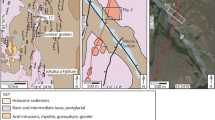Abstract
The relics of two Late Devonian subaqueous rhyolitic dome-top tuff and pumice cone successions are preserved in the Bunga Beds outlier of the Boyd Volcanic Complex, southeastern Australia. These cone successions and other rhyolitic volcanics of the Bunga Beds are associated with turbidite and other deep-water massflow sedimentary rocks. The two cone successions have a generally similar stratigraphy. At the base, flow-banded, variably autobrecciated and quench-fragmented rhyolite, representing an intrusive to extrusive dome, is overlain by rhyolitesediment breccia, representing extrusion of the dome through the deep-water sediment pile and resedimentation down its flanks. In the northern cone succession an overlying, succession of bedded pumiceous crystal-rich to crystal-poor tuffs represents the onset of pyroclastic activity and growth of a tuff cone. An overyling debris flow deposit represents degradation of part of the cone. The topmost unit, a stratified pumice succession, is thought to represent another cone-building eruptive phase, and is separated from the underlying strata by a major slide surface. The southern cone succession contains less tuff and abundant pumice, and is also terminated by a debris-flow deposit, indicating cone degradation. A modern analogue for the inferred eruptive style and sequence is the 1953–1957 rhyolite eruption that formed the Tuluman Island lava-tuff cone complex in the Bismarck Sea. The eruptions were often cyclical consisting of an initial inferred submarine-lava-forming stage, passing into a pumicecone-forming stage, in some cases a subaeriallava-forming stage, and a final stage, following the cessation of volcanism, during which the cones collapsed gravitationally or were destroyed by wave erosion. Using observations from both the Tuluman Island eruptions and the preserved stratigraphies of the Devonian tuff cones, a dynamic model is proposed for the formation of subaqueous rhyolitic dome-top tuff and pumice cones.
Similar content being viewed by others
References
Burnham CW (1983) Deep marine pyroclastic eruptions. In: Ohmoto H, Skinner BJ (eds) The Kuroko and related volcanogenic massive sulphide deposits. Econ Geol Mon 5:142–148
Cas RAF (1979) Mass-flow arenites from a Paleozoic interarc basin, New South Wales, Australia: Mole and environment of emplacement. J Sed Petrology 49:29–44
Cas R, Allen R, Bull S, Clifford, B, Wright J (1986) Subaqueous rhyolitic volcanism: complex facies associations in a rift basin. In: International Volcanological Congress Abstracts. IAVCEI and Royal Soc of NZ, p 363
Cas RAF, Wright JV (1987) Volcanic Successions modern and ancient: a geological approach to processes, products and successions Allen and Unwin, London
Dott RH, Bourgeouis J (1982) Hummocky stratification: significance of its variable bedding sequences. Geol Soc Am Bull 93:663–680
Fergusson CL, Cas RAF, Collins WJ, Craig GY, Crook KAW, Powell McA, Scott PA, Young GC (1979) The Upper Devonian Boyd Volcanic Complex, Eden, NSW. J Geol Soc Aust 26:87–105
Fisher RV, Schmincke H-U (1984) Pyroclastic rocks. Springer, Berlin Heidelberg New York
Fiske RS Matsuda T (1964) Submarine equivalents of ash flows in the Tokiwa Formation, Japan. Am J Sci 262:76–106
Kokelaar BP (1982) Fluidisation of wet sediments during the emplacement and cooling of various igneous bodies. J Geol Soc Lond 139:21–33
Lowe DR (1982) Sediment gravity flows: II, depositional models with special reference to the deposits of high density turbidity currents. J Sed Pet 52:279–297
McBirney AR (1963) Factors governing the nature of submarine volcanism. Bull Volcanol 26:455–469
Middleton GV, Hampton MA (1973) Sediment gravity flows: mechanics of and deposition. In: Middleton GV, Bauna AH (eds) Turbidites and deep water sedimentation. Soc Econ Paleontol Mineral Shortcourse Pacific Section, Los Angeles:1–38
Reynolds MA, Best JG (1976) Summary of 1953–1957 eruption of Tuluman volcano, Papua New Guinea. In: Johnson RW (ed) Volcanism in Australasia Elsevier, Amsterdam, pp 287–296
Reynolds MA, Best JG, Johnson RW (1980) 1953–1957 eruption of Tuluman volcano: rhyolitic volcanic activity in the northern Bismarck Sea. Geol Surv Papua New Guinea Mem 7
Sheridan MF, Wohletz KH (1981) Hydrovolcanic explosions: the systematics of water-pyroclast equilibration. Science 212:1387–1389
Walker RG (1984) Turbidites and associated coarse clastic deposits. In: Walker RG (ed) Facies Models Geol Assoc Can 171–188
Whitham A, Sparks RSJ (1986) Pumice. Bull Volcanol 48:209–223
Author information
Authors and Affiliations
Rights and permissions
About this article
Cite this article
Cas, R.A.F., Allen, R.L., Bull, S.W. et al. Subaqueous, rhyolitic dome-top tuff cones: a model based on the Devonian Bunga Beds, southeastern Australia and a modern analogue. Bull Volcanol 52, 159–174 (1990). https://doi.org/10.1007/BF00334802
Received:
Accepted:
Issue Date:
DOI: https://doi.org/10.1007/BF00334802




